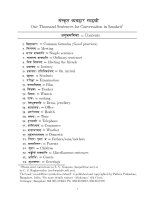lexicology for test in Hanu University
Bạn đang xem bản rút gọn của tài liệu. Xem và tải ngay bản đầy đủ của tài liệu tại đây (151.54 KB, 18 trang )
1. Major peculiarities of the word: (Đặc tính chủ yếu của từ)
- External of structure of the word = morphological structure (cấu trúc bề mặt =
cấu trúc hình thái học).
E.g: post-impressionists: external structure of this word is constituted by the
following morphemes (cấu trúc hình thái được tạo nên từ các hình vị sau):
- the prefixes: post-, im-
- the root: press
- the noun-forming suffixes: -ion, -ist
- the grammatical suffix of plurality: -s
E.g: dishonestly:
-the prefix: dis-
- the root: honest
- the adverd-forming suffix: -ly
- Internal structure of the word = its meaning = semantic structure of the word:
E.g: manufacture: make smt, in large number, with the help of machinery
Creat: make smt, original, requiring skill, dexterity.
=> Word is a speech unit used for the purposes of human communication,
materially representing a group of sounds, possessing a meaning, susceptible
to grammatical employment and characterized by formal and semantic unity.
2. The Etymological Structure of English Vocabulary
The Native element The borrowed element
I. Indo-European
element
I. Celtic (5-6
th
c.A.D)
II. Germanic element II. Latin
1
st
group: 1
st
c.B.C
2
nd
group: 7
th
c.A.D
3
rd
group: the Renaissance period
III. English Proper
element (not earlier
than 5
th
c.A.D)
III. Scandinavian (8-11
th
c.A.D)
IV. French
1. Normal borrowings: 11-13
th
c.A.D)
2. Parissian borrowings (Renaissance)
V. Greek (Renaissance)
VI. Italian (Renaissance and later)
VII. Spanish (Renaissance and later)
VIII. German
IX. Indian
X. Russian
3. Native Element in English
- Articles (mạo từ)
- Prepositions (giới từ)
- Pronouns (đại từ)
- Conjunctions (liên từ)
- Auxiliaries (trợ động từ)
- words denoting everyday objects and ideas
Indo-European Group:
- Family relations (từ chỉ các mối quan hệ gia đình): father, mother, brother
- Parts of the human body (từ chỉ các bộ phận cơ thể con người): foot, nose, lip
- Animals (từ chỉ các loài động vật): cow, swine, goose
- Plants (từ chỉ các loại thực vật): corn, tree, birch
- Times of day (từ chỉ thời gian trong ngày): day, night
- Heavenly bodies (từ chỉ các yếu tố trên không gian): star, moon, sun
- Numerous adjectives (tính từ): red, new, glad
- Pronouns: personal, demonstrative
- Numerous verbs: be, sit, eat
Germanic Element:
- Parts of the human body: head, hand, arm
- Animals: fox, calf, bear
- Plants: oak, fir, grass
- Natural phenomena: rain, frost
- Seasons of the year: winter, spring, summer
- Landscape features: sea, land
- Human dwellings and furniture: house, room, bench
- Sea-going vessels: boat, ship
- Adjectives: green, blue, grey, white
- Verbs: see, hear, speak, tell, say
English Proper
4. The borrowed element
1. Celtic
Celtic words: bald, down, glen, druid, bard, cradle
Place names, names of rivers, hills (names of many parts and features of
their territory): Avon, Exe, Eskm Usk, Ux
2. Latin
- 1
st
B.C:
Names of new fruits and vegetables: butter, cheese, cherry, pear, plum…
Some more examples: cup, kitchen, mill
- 7st A.D: names of persons, objects, and ideas associated with church and
religious rituals
- The Renaissance Period:
Abstract words (từ trừu tượng): filial, moderate, intelligent, elect, creat
Numerous scientific and artistic terms: datum, status, phenomenon, music,
phylosophy
3. Scandinavian (8-11
th
c.A.D)
Ski-: ski, skate, sky, skill, skin
4. French
4.1. Normal borrowings: 11-13
th
c.A.D
Administrative words: government, council, power, state
Legal terms: court, crime, prison, judge, justice
Military terms: war, soldier, battle, officer, army
Educational terms: pupil, pen, pencil, lesson, library
Numerous terms: plate, saucer, autumn, uncle, river
4.2. Parissian borrowings (Renaissance)
Police, machine, ballet, matinée, technique
5. Greek (Renaissance)
Numerous scientific and artistic terms: cycle, ethics, esthete, atom
6. Italian (Renaissance and later)
Opera, alarm, colonel, piano, violin
7. Spanish (Renaissance and later)
8. German
9. Indian
10. Russian
5. Word-building
Morphemes: smaller units which constitute the words. Morphemes do not
occur as free forms but only constituents of words. Yet they possess meaning of
their own.
All morphemes are subdivided into 2 large classes: free -> roots (or radicals)
and bound -> affixes (prefixes and suffixes)
5.1. Root words: house, book, tree, plant, see, heard -> have only a root morpheme
in its structure => conversion
The hammer -> to hammer
The nail -> to nail
Dog -> to dog
Wolf -> to wolf
Hand -> to hand
5.2. Derived words = a root + an affix (or several affixes) => affixation (or
derivation). E.g: invisible, invaluable
5.3. Compound words = 2 or more stems => composition. E.g: dancing-hall,
dancing-partner, mother-in-law…
Compounds:
+ Structurally:
Neutral compounds:
+++ simple neutral compound = affixless stems. E.g: sunflower,
bedroom, tallboy…
+++ Derivational compounds have affixes in their structure. E.g:
absent-mindedness, blue-eyed, music-lover…
+++ Contracted compounds have shortened stem in their structure.
E.g: TV-set, V-day, H-bag…
Morphological compounds. E.g: Anglo-saxon, handiwork, spokesman,
sportscar, statesman…
Syntactic compounds: lily-of-the-valley, merry-go-round, mother-in-
law, up-to-date…
+ Semantically: basing on the degree of semantic cohesion of the
constituent parts, it is divided into 2 groups:
Non – Idiomatic compounds: their meanings do not correspond to the
separate meanings of their constituent parts: classroom, bedroom, working-man,
sleeping-car…
Idiomatic compounds: their meanings correspond to the separate
meanings of their constituent parts: blackboard, blackbird, football, pickpocket,
chatterbox, ladybird, tallboy, bluestocking, butter-finger, man-of-war, merry-go-
round, horse-marine…
5.4. Shortenings. E.g: Laboratory-> lab, influenza -> flu
+ Clipping: airplane -> plane, influenza -> flu, examination -> exam,
mathematics -> maths
+ Abbreviation: NATO = North Atlatic Treaty Organization
+ Initial Shortenings: Gif = Girl Friend
+ Blending: Channel + tunnel => Chunnel
Camera + recorder => Camcorder
Breakfast + lunch => Brunch
Spoon + fork => Spork
6. Meaning
Generally speaking, Meaning can be more or less described as a component
of the word through which a concept is communicated, in this way endowing the
word with the ability of denoting real objects, qualities, actions and abstract
notions.
Types of semantic components:
- Denotations (Denotative Components): expresses the conceptual of a
word.
- Connotations (Connotative Components):
E.g:
Lonely: alone, without company (Denotation)
melancholy, sad (Emotive connotation)
Glare: to look (Denotation)
steadily, lastingly (Connotation of duration)
in anger, rage, etc. (Emotive connotation)
CAUSES OF DEVELOPMENT OF NEW MEANINGS
- The first group of causes is traditionally termed historical or extra-
linguistic. E.g: carriage: a vehicle drawn by horses -> new meaning: a railway
car -> the new travelling conveyance was also naturally associated in people’s
mind with the old one: horse – drawn vehicle > part of railway train. The job of
both, horse-drawn carriage and the railway carriage, is the same: to carry
passengers on a journey.
- The second group of causes is linguistic factors
E.g: deer: any beast ->a certain kind of beast
It is important to note that in any case of semantic change, it is not the
meaning but the word that is being transferred from one referent onto another. The
result of such tranference is the appearance of a new meaning.
2 Types of transference:
- Transference based on Resemblance (Similarity): this type of
tranference is also refered to as linguistic metaphor. A new meaning appears as a
result of associating 2 objects due to their outward similarity. Carriage is an
example of this type of tranference.
Eye: hole in the end of a needle (kim khâu): based on resemblance of shape.
Drop: (a small particle of water or other liquid) -> new meanings: earrings
(hoa tai) shaped as drops of water; candy of the same shape (viên kẹo).
Bar: original meaning barrier -> developed a figurative meaning realized in
such contexts as social bar, colour bar.
- Transference based on Contiguity: is refered to linguistic metonymy.
The association is based upon subtle psychological links between different
objects and phenomena, sometimes traced and identified with much difficulty.
2 objects may be associated together because they often appear in common
situations, and so the image of one is easily accompanied be the image of the other;
or they may be associated on the principle of cause and effect, of common
function, of common position, of some material and an object which is made of it.
+ Name of a container for what is contained: pint, a bottle (of wine)
+ Geographical names for the products: china, tweed, cheviot
+ Proper names as common names: sandwich, volt, watt
+ Names of material for the product: mink, iron, taffeta
+ Names of a separate part for a whole thing or vice versa:
They live under the same roof.
Your car needs servicing.
Glad: old meaning: bright, shining (applied to the sun, gold, precious stones,
shining armour…) new meaning: joyful developed on the basic of the usual
association of light with joy.
Hand of the clock: originates from the main meaning of this noun part of
human body. It developed due to the association of common function.
The result of tranference:
1. Generalization (Broadening) of the meaning:
Sometimes, the process of transference may result in a considerable change
in range of meaning. The range of the second meaning may be much broader/ more
general or more narrow than that of the original meaning.
E.g:
To arrive (French borrowing):
- The original meaning: to come to shore, to land
- The second meaning: to come -> to arrive in a village, town, city, at a
hotel, hostel, etc.
-> The meaning developed through transference based on contiguity
Pipe:
- The earliest recorded meaning: a musical instrument
- The general meaning: any hollow oblong cylindrical body (water pipe)
-> The meaning developed through transference based on similarity of shape
which finally led to a considerable broadening of the range of meaning.
Bird:
- The original meaning: young of a bird
- The modern meaning: a creature with feathers and wings, usually able to
fly
-> The modern meaning developed through transference based on contiguity.
2. Specialization (Narrowing) of the meaning:
Word The original meaning The narrowing meaning
Deer Any beast A certain kind of beast
Meat Any food A certain food product
Boy Any young person of
male sex
Servant of the male sex
-> In all these words, the second meaning developed through transference
based on contiguity.
3. Degeneration/Degradation and elevation of meaning
These terms are open to question because they seem to imply (ngụ ý, bao
hàm) that meaning can become “better” or “worse” which is neither logical nor
plausible (hợp lí).
3.1. Degeneration of meaning
Word The original meaning The second meaning
Knave Boy Swindler, scoundrel
(to denote a person of bad
repute or characteristics)
Villain Farm-servant, serf Base, vile person
-> Semantically speaking, the second meaning developed a negative
evaluative connotation which was absent in the first meaning.
3.2. Elevation of meaning
Word The first meaning The second meaning
1. Fond Foolish Loving, affectionate
The situation is reserved: the first
meaning has a negative evaluative
connotation, and the second
meaning has not. It is difficult to
see what is actually “evaluated”
here. Certainly, it is not the
meaning of the word
2. Nice Foolish Fine, good
3. Tory Brigand,
highwayman
Member of the Tories
The first meaning has a pronounced
negative connotation which is
absent in the second meaning.
Semantically speaking, the first one
is just as good as the second, and
the difference lies only in the
connotative structure
4. Knight Manservant Noble, courageous
man
The second meaning acquired a
positive evaluative connotation that
was absent in the first meaning. So,
here, once more, we are faced with
a mere readjustment of the
connotative components of the
word
5. Marshal Manservant
attending horses
The highest rank in the
army
In these words, the second meaning
developed due to the process of
transference based on contiguity.
Lord and lady are also examples of
narrowing of meaning if we
compare the range of the original
and of the resultant meanings. No
connotation of evaluation can be
6. Lord Master of the
house, head of the
family
Baronet (aristocratic
title)
7. Lady Mistress of the
house, married
Wife or daughter of
baronet
woman
observed in either of the meanings.
The fact that in all these cased, the
original meaning denoted a humble
ordinary person and the second
denotes a person of high rank is
absolutely extra-linguistic.
-> All of that has been said and the examples that have been given show that the
terms “degradation” and “elevation” of meaning are imprecise and do not seem to
be an objective reflection of the semantic phenomenon they describe.
It would be more credible to state that some cases of transference based on
contiguity may result in development or loss of evaluative connotations.
7. Homonyms
7.1. Definition
Homonyms are words which are identical in sound and spelling, or, at least,
in one of these aspects, but different in their meaning.
E.g:
- Ball: a large formal occasion where people dance
- Ball: a sphere, any spherical body
- Sent - cent - scent
- site - cite - sight
- right - rite - write - wright
- Bank: + financial institution
+ a shore of a river
- bear: + a large heavy animal with thick fur
+ to give birth to
+ to tolerate
Their identical forms are mostly accidental: the majority of homonyms
coincided due to phonetic changes which they suffered during development.
In the process of communication they are more of an encumbrance, leading
sometimes to confusion and misunderstanding. Yet it is this very characteristics
which makes them one of the most important sources of popular humor.
7.2. Types of Homonyms
a, Homonyms proper (đồng âm, đồng tự)
Homonyms which are the same in sound and spelling are traditional termed
homonyms proper.
- Jet: + a thin stream of smt, such as water or gas, which is forced out of a
small hole
+ a hard black stone which shines when it is rubbed and is used to
make jewellery and other decorative objects.
b, Homophones (phát âm giống nhau nhưng viết khác nhau): same in sound
but different in spelling.
- Hour: means a twenty-fourth part of a day and night
Our: means belonging to us
- Bean / been
- night / knight
- piece / peace
- scent / cent / sent
c, Homographs are the words which are the same in spelling but different in
sound.
- Lead /li:d/: to conduct on the way, go before to show the way
Lead /led/: a heavy mental / a very dense, dark-grey, poisonous metal
- Bow /bau/ (v): to incline the head or body in salutation
Bow / bou/ (n): a flexible strip of wood for propelling arrows
7.3. Source of homonyms
a, Phonetic changes:
b, Borrowing
c, Word-building
Conversion
- Comb (n) / to comb (v)
- Pale (adj) / pale (v)
- To make / make (n)
Shortening
- Fan: is a shortening produced from fanatic which means an enthusiastic
admirer of some kind of sport or of an actor, singer, etc.
Fan: means an implement for waving lightly to produce a cool current of air.
- Rep : repertory / representative / reputation
- Bang: a loud, sudden explosive noise
Bang: a fringe of hair combed over forehead
d, Split polysemy
Two or more homonyms can originate from different meanings of the same
word when, for some reason, the semantic structure of the word breaks into
several parts.
Board: a long and thin piece of timber
daiy meals, esp. as provided for pay
an official group of persons who direct or supervise some
activity.
Spring: the act of springing, a leap
a place where a stream of water comes up out of the earth
a season of the year
7.4. Classification of homonyms
a, Full homonyms
Full lexical homonyms are words which represent the same category of parts
of speech and have the same paradigm.
E.g:
Match: a game, a contest
a short piece of wood used for producing fire
Wren:member of the Women’s Royal Naval Service
a bird
b, Partial Homonyms are subdivided into 3 subgroups:
- Simple lexico-grammatical partial homonyms are words which belong to the
same category of parts of speech. Their paradigm have one identical form, but it is
never the same form.
E.g: To found
Found (past.indef of to find)
To lay
lay (past.indef of to lie)
- Complex lexico-grammatical partial homonyms are words of different
categories of parts of speech which have one identical form in their paradigms
E.g: Rose (n) - Rose (past.indef of to rise)
Maid (n) - made (past.indef, past part of to make)
Left (adj) - left (past.indef, past part of to leave)
Bean (n) - been (past.indef, past part of to be)
- Partial lexical homonyms are words of the same category of parts of speech
which are identical only in their corresponding forms.
E.g: To lie (lay / lain) (v)
To lie (lied / lied) (v)
To hang (hung / hung) (v)
To hang (hanged / hanged) (v)
8. Synonyms
8.1. What is synonyms?
Synonyms are words belonging to the same part of speech and possesing one
or more identical or nearly identical denotational meanings, interchangeable in
some contexts.
E.g: like, admire, love: describe feelings of attraction, approbation, fondness.
Movie, film, flick: refer to the same set of referents in the real world.
- Movie may strike U as American
- Film may strike U as British or as appropriate for movie classics or art
movies
- Flick is used chiefly in very informal contexts
Fast, quick, rapid: may be used interchangeably in reference to smb’s
running speed
- Fast talker: one who is able to get out of trouble by talking cleverly
- Quick talker: one who usually talks in a rapid manner
Some ppl may lead their lives in the fast lane, not in the rapid lane or in the
quick lane
He has a quick mind, not a rapid mind or a fast mind
He gave her a quick glance, not a rapid glance or a fast glance.
- Rapid is usual term when reference is made to a person’s strides, esp.
metaphorical strides
8.2. Criteria of Synonymy
a, Notional criterion
b, Semantic criterion
c, Criterion of interchangeability
8.3. Types of synonyms
- Ideographic: Words conveying the same notion but differing in shades of
meaning. (đồng nghĩa theo ý)
- Stylistic: differing in stylistic characteristic (đồng nghĩa tu từ)
- Absolute: coinciding in all their shades of meaning and in all their stylistic
characteristics. (đồng nghĩa tuyệt đối)
9. EUPHEMISMS (UYỂN NGỮ)
9.1. What is euphemisms?
Euphemism is a figure of rhetoric by which an unpleasant or offensive thing
is describes or referred to by a milder term.
9.2. Euphemisms in use
- Euphemisms in daily life
- Euphemisms in business
9.3. Why euphemisms?
- Not to hurt someone’s feeling, to be more polite.
- Social taboos (Điều cấm kỵ xã hội)
- Superstitious taboos
- Political taboos
10. ANTONYMS (TỪ TRÁI NGHĨA)
10.1. What is an antonym?
Antonyms are words which have the same category of parts of speech, but
have contrasting meanings.
E.g: cold - warm, sorrow - gaiety, pass - fail, hot - cold, thinner - fatter, true - false,
big - small, buy - sell
Dull: has the antonyms:
- interesting, amusing, entertaining for its meaning of “deficient in interest”.
- clever, bright, capable for its meaning of “deficient in intellect”.
- active for the meaning of “deficient in activity”.
10.2. Classification of antonyms:
a, Root-word antonyms: are those words which are completely different in sound
and form
E.g:
in / out
thin / fat
give / take
big / small
b, Derivational antonyms: are words which are formed by derivation (they
originate from the same root)
E.g:
Decisive / indecisive
Proper / Improper
Code / Decode
Connect / Disconnect









